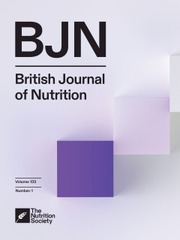Crossref Citations
This article has been cited by the following publications. This list is generated based on data provided by
Crossref.
Whalley, L. J.
Fox, H. C.
Lemmon, H. A.
Duthie, S. J.
Collins, A. R.
Peace, H.
Starr, J. M.
and
Deary, I. J.
2003.
Dietary supplement use in old age: associations with childhood IQ, current cognition and health.
International Journal of Geriatric Psychiatry,
Vol. 18,
Issue. 9,
p.
769.
DeMar, James C.
Ma, Kaizong
Bell, Jane M.
and
Rapoport, Stanley I.
2004.
Half‐lives of docosahexaenoic acid in rat brain phospholipids are prolonged by 15 weeks of nutritional deprivation of n‐3 polyunsaturated fatty acids.
Journal of Neurochemistry,
Vol. 91,
Issue. 5,
p.
1125.
Whalley, Lawrence J
Fox, Helen C
Wahle, Klaus W
Starr, John M
and
Deary, Ian J
2004.
Cognitive aging, childhood intelligence, and the use of food supplements: possible involvement of n−3 fatty acids.
The American Journal of Clinical Nutrition,
Vol. 80,
Issue. 6,
p.
1650.
Raynaud-Simon, Agathe
2004.
Nutrition, démences vasculaires et maladie d’Alzheimer.
Nutrition Clinique et Métabolisme,
Vol. 18,
Issue. 4,
p.
181.
PEREIRA, Suzette L.
LEONARD, Amanda E.
HUANG, Yung-Sheng
CHUANG, Lu-Te
and
MUKERJI, Pradip
2004.
Identification of two novel microalgal enzymes involved in the conversion of the ω3-fatty acid, eicosapentaenoic acid, into docosahexaenoic acid.
Biochemical Journal,
Vol. 384,
Issue. 2,
p.
357.
Song, Cai
and
Horrobin, David
2004.
Omega-3 fatty acid ethyl-eicosapentaenoate, but not soybean oil, attenuates memory impairment induced by central IL-1β administration.
Journal of Lipid Research,
Vol. 45,
Issue. 6,
p.
1112.
Calon, Frédéric
Lim, Giselle P.
Yang, Fusheng
Morihara, Takashi
Teter, Bruce
Ubeda, Oliver
Rostaing, Phillippe
Triller, Antoine
Salem, Norman
Ashe, Karen H.
Frautschy, Sally A.
and
Cole, Greg M.
2004.
Docosahexaenoic Acid Protects from Dendritic Pathology in an Alzheimer's Disease Mouse Model.
Neuron,
Vol. 43,
Issue. 5,
p.
633.
Jansson, Erik T.
2005.
Alzheimer disease is substantially preventable in the United States – review of risk factors, therapy, and the prospects for an expert software system.
Medical Hypotheses,
Vol. 64,
Issue. 5,
p.
960.
Ruxton, C. H. S.
Calder, P. C.
Reed, S. C.
and
Simpson, M. J. A.
2005.
The impact of long-chainn-3 polyunsaturated fatty acids on human health.
Nutrition Research Reviews,
Vol. 18,
Issue. 1,
p.
113.
Jayasooriya, Anura P.
Ackland, M. Leigh
Mathai, Michael L.
Sinclair, Andrew J.
Weisinger, Harrison S.
Weisinger, Richard S.
Halver, John E.
Kitajka, Klára
and
Puskás, László G.
2005.
Perinatal ω-3 polyunsaturated fatty acid supply modifies brain zinc homeostasis during adulthood.
Proceedings of the National Academy of Sciences,
Vol. 102,
Issue. 20,
p.
7133.
Hallahan, Brian
and
Garland, Malcolm R.
2005.
Essential fatty acids and mental health.
British Journal of Psychiatry,
Vol. 186,
Issue. 4,
p.
275.
Araujo, Joseph A.
Studzinski, Christa M.
Head, Elizabeth
Cotman, Carl W.
and
Milgram, Norton W.
2005.
Assessment of nutritional interventions for modification of age-associated cognitive decline using a canine model of human aging.
AGE,
Vol. 27,
Issue. 1,
p.
27.
Moyad, Mark A.
2005.
An introduction to dietary/supplemental omega-3 fatty acids for general health and prevention: Part II.
Urologic Oncology: Seminars and Original Investigations,
Vol. 23,
Issue. 1,
p.
36.
Lim, WS
Gammack, JK
Van Niekerk, J
Dangour, AD
and
Lim, Wee-Shiong
2005.
The Cochrane Database of Systematic Reviews.
Marszalek, Joseph R.
and
Lodish, Harvey F.
2005.
DOCOSAHEXAENOIC ACID, FATTY ACID–INTERACTING PROTEINS, AND NEURONAL FUNCTION: Breastmilk and Fish Are Good for You.
Annual Review of Cell and Developmental Biology,
Vol. 21,
Issue. 1,
p.
633.
Jensen, Craig L
Voigt, Robert G
Prager, Thomas C
Zou, Yali L
Fraley, J Kennard
Rozelle, Judith C
Turcich, Marie R
Llorente, Antolin M
Anderson, Robert E
and
Heird, William C
2005.
Effects of maternal docosahexaenoic acid intake on visual function and neurodevelopment in breastfed term infants.
The American Journal of Clinical Nutrition,
Vol. 82,
Issue. 1,
p.
125.
Shrivastava, Ravi
Vincent, Bernard
Gobron, Stephane
Cucuat, Nathalie
and
John, Gareth W.
2005.
Evidence for growth-promoting effects of Omega n −3 fatty acids alone and in combination with a specific vitamin and mineral complex in rat neuroblastoma cells.
Nutritional Neuroscience,
Vol. 8,
Issue. 5-6,
p.
317.
de Lau, L.M.L.
Bornebroek, M.
Witteman, J. C.M.
Hofman, A.
Koudstaal, P. J.
and
Breteler, M. M.B.
2005.
Dietary fatty acids and the risk of Parkinson disease.
Neurology,
Vol. 64,
Issue. 12,
p.
2040.
Calon, Frédéric
Lim, Giselle P.
Morihara, Takashi
Yang, Fusheng
Ubeda, Oliver
Salem, Norman
Frautschy, Sally A.
and
Cole, Greg M.
2005.
Dietary n‐3 polyunsaturated fatty acid depletion activates caspases and decreases NMDA receptors in the brain of a transgenic mouse model of Alzheimer's disease.
European Journal of Neuroscience,
Vol. 22,
Issue. 3,
p.
617.
Jensen, Craig L
Voigt, Robert G
Prager, Thomas C
Zou, Yali L
Fraley, J Kennard
Rozelle, Judith C
Turcich, Marie R
Llorente, Antolin M
Anderson, Robert E
and
Heird, William C
2005.
Effects of maternal docosahexaenoic acid intake on visual function and neurodevelopment in breastfed term infants.
The American Journal of Clinical Nutrition,
Vol. 82,
Issue. 1,
p.
125.


